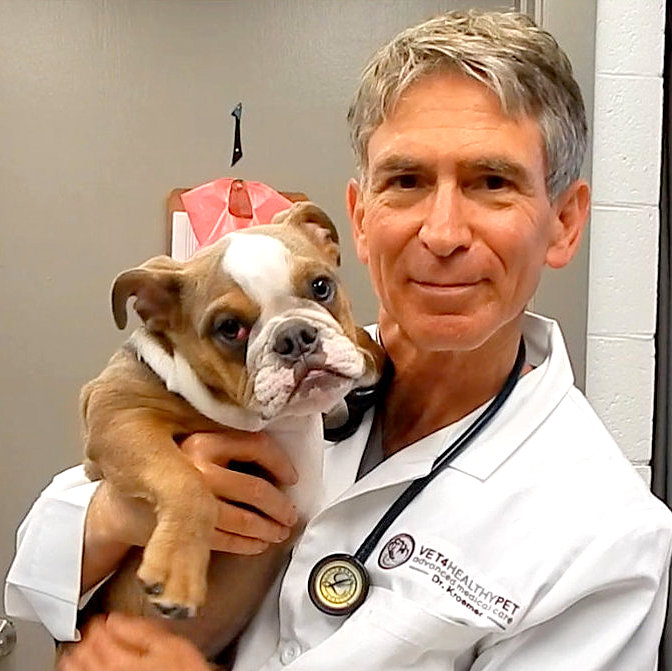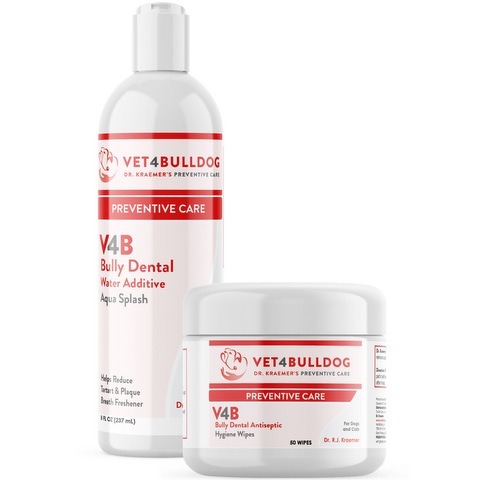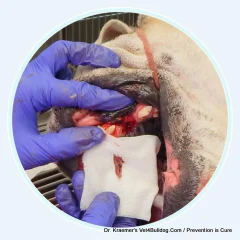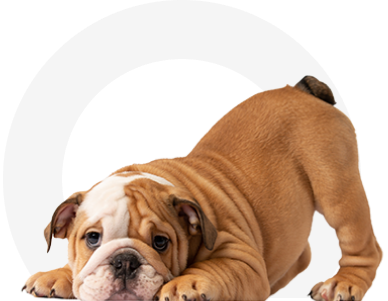Introduction To Bulldog and French Bulldog Dental Problems 🦷
Dental disease is among the most common health issues affecting Bulldogs and French Bulldogs. Studies show that 85% of dogs and cats over the age of three suffer from some form of periodontal disease, making it the number one medical concern in companion animals.
This article outlines the typical progression of dental disease in Bulldogs, beginning with plaque formation and leading to tooth loss and systemic health risks if left untreated.
Common Forms of Bulldog Dental Disease
➡️ Plaque – A soft, sticky film of bacteria that forms on the teeth
➡️ Tartar (Calculus) – Hardened plaque that attaches firmly to the tooth surface
➡️ Gingivitis – Inflammation of the gums, often the first visible sign of dental disease
➡️ Gum Disease – A general term for infections and inflammation of the gum tissue
➡️ Periodontitis – Advanced gum disease where infection spreads beneath the gum line, damaging bone and supporting structures of the teeth
Anaerobe bacteria are the most common cause of periodontitis.
What is The Sequence of Dental Disease Development?
1️⃣🚫 Pellicle Formation: The process begins with the formation of a pellicle, a thin protein film that naturally develops on the surface of the teeth. This occurs even in healthy Bulldog puppies.
2️⃣🚫 Bacterial Colonization: The pellicle provides an ideal surface for bacterial adhesion. Initially, aerobic bacteria begin to colonize the teeth.
3️⃣🚫 Plaque Accumulation: Within just a few days, the bacterial colonies grow, and the plaque layer thickens.
This early plaque is composed mainly of
- bacteria
- food particles
- and saliva.
4️⃣🚫 Anaerobic Shift: As plaque accumulates and oxygen becomes scarce beneath the gumline, anaerobic bacteria — including motile rods and spirochetes — begin to dominate. These bacteria thrive in low-oxygen environments and are more harmful to oral tissues.
5️⃣☠️ Endotoxin Release: Anaerobic bacteria release endotoxins, which are toxic to gum tissues and can initiate a destructive immune response. These endotoxins not only damage local oral tissues but can also contribute to systemic disease affecting the
- heart (endocarditis)
- kidneys (glomerulonephritis)
- liver (hepatitis)
- gut microbiome (dysbiosis and leaky gut)
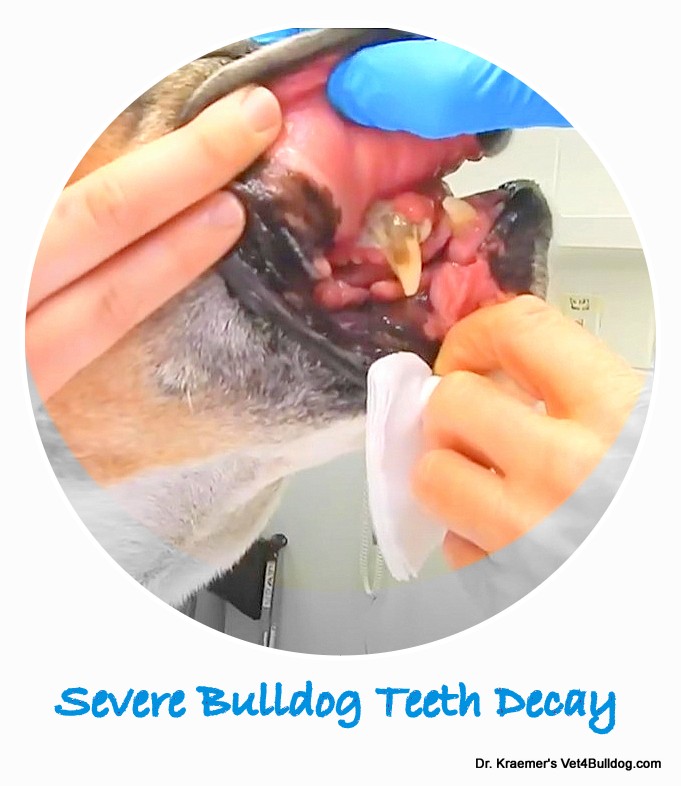
4 Stages of Bulldog and French Bulldog Dental Disease
Stage 1️⃣: Inflammation
Stage 2️⃣ : Edema, gingival bleeding upon probing
Stage 3️⃣: Pustular discharge, slight to moderate bone loss
Stage 4️⃣: Mobility and severe bone loss
” 85% of dogs and cats over the age of 3 have dental disease, making it their #1 medical problem.”
Systemic Illness Risks from Dental Disease in Bulldogs and French Bulldogs
Untreated dental disease doesn’t just affect the mouth—it can impact your bulldog’s entire body. Bacteria from infected gums can enter the bloodstream and contribute to serious health problems, including:
➡️Heart Valves – Endocarditis and other cardiac complications
➡️Brain – Inflammation and potential neurological effects
➡️Kidneys – Reduced function or chronic kidney disease
➡️Liver – Liver inflammation and impaired detoxification
➡️ Digestive Tract – Imbalance of gut bacteria and gastrointestinal irritation
Dental disease is a whole-body risk. Preventing it protects your bulldog’s health far beyond the mouth.

How to Prevent Bulldog and French Bulldog Dental Problems?
There are a few simple steps you can take to help prevent bulldog dental problems
#1 Bulldog Daily Teeth Brushuing Benefits:
Daily toothbrushing, with or without dog-safe toothpaste, is one of the most effective ways to prevent dental disease in Bulldogs and French Bulldogs. Regular brushing helps remove plaque before it hardens into tartar and leads to gingivitis, bone loss, or more severe periodontal issues.
Given the breed’s predisposition to dental problems due to their compact jaws and crowded teeth, Bulldogs benefit greatly from a consistent oral hygiene routine. While specialized enzymatic pet toothpaste can enhance the effect, the mechanical action of brushing alone plays the most critical role in reducing plaque and maintaining healthy gums.
Training your bulldog to accept toothbrushing early on—using gentle techniques and positive reinforcement—can significantly
🪥 improve long-term oral health
🪥 reduce the need for frequent dental procedures under anesthesia.
#2 Dr. Kraemer’s Bulldog Dental Therapeutics
In addition to professional dental cleanings and daily brushing, non-prescription dental therapeutics play a valuable role in maintaining oral health in Bulldogs and French Bulldogs. Dr. Kraemer’s V4B (Vet4Bulldog) line of dental products offers both topical solutions and oral supplements designed specifically for the unique needs of bully breeds.
🌿V4B Bully Dental Antiseptic Wipes: Easy-to-use, medicated wipes that reduce
- plaque buildup
- freshen breath
- remove subgingival hair
- support healthy gums
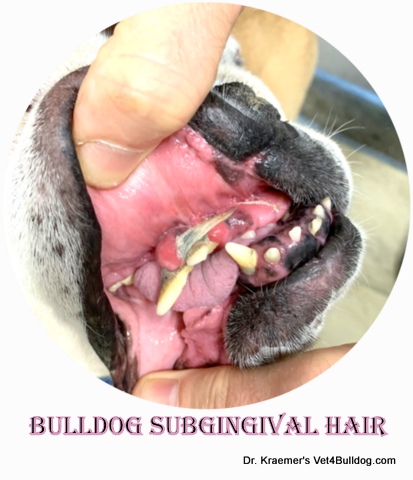
🌿V4B Bully Dental Water Additive: A tasteless, easy-to-administer formula added to drinking water to help fight plaque and bacteria.
🌿V4B Bully Immune Support: Enhances the immune response, which is crucial in fighting oral inflammation and infection.
🌿V4B Bully Comfort & AcheLess: A natural anti-inflammatory supplement that supports gum comfort and reduces oral discomfort associated with dental disease.
🌿V4B Bully Probiotic & Digestive Enzymes: help replace the normal important microbiome
These products are safe for daily use, require no prescription, and can be an effective addition to a comprehensive dental care routine
#3 Bulldog Routine Oral Exam:
Your bulldog puppy should have their teeth checked at least once a year. Your bulldog and other pets may require dental care if:
• Presence of a red stripe along the gum line
• Unpleasant odor from the mouth
• Reluctance to chew
• Change in chewing behaviors
• Inability to see the teeth due to calculus accumulation
• Broken or discolored teeth
• Loose teeth
• Draining or swelling around the face or jaw
• Decreased appetite
• Swelling or enlargements of the oral tissues
• Difficulty swallowing
• Rubbing the face with a paw (sometimes resulting in eye irritation)
• Rubbing the face on the floor or other surfaces
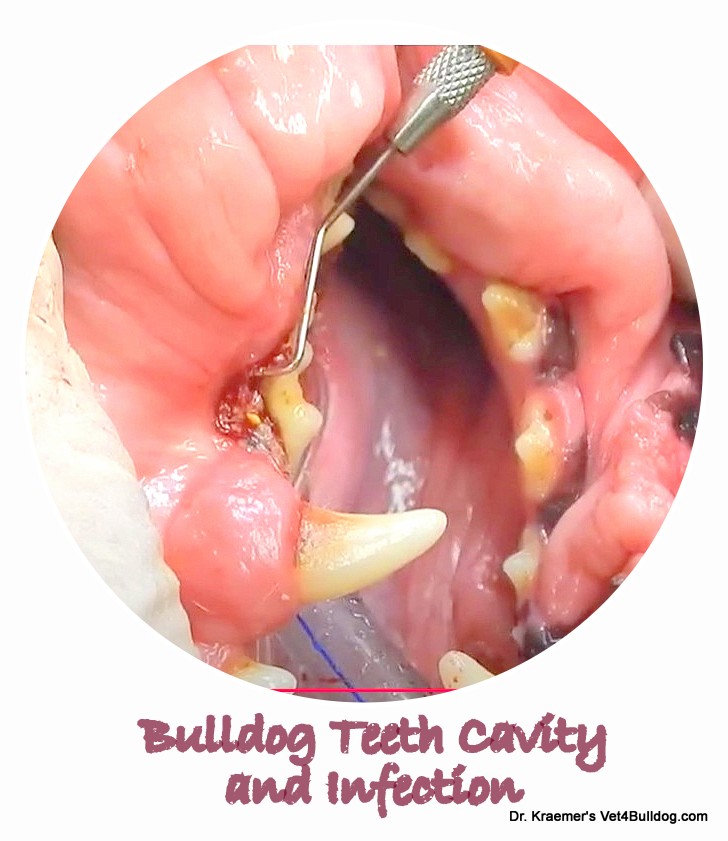
#4 Bulldog and French Bulldog Dental Radiographs
Dental radiographs are essential for diagnosing conditions that are not visible during a routine oral examination. These include issues occurring below the gum line, such as
- impacted teeth
- infected or abscessed roots
- bone loss, and cavities
— all of which are common in Bulldogs and French Bulldogs due to their unique craniofacial anatomy.
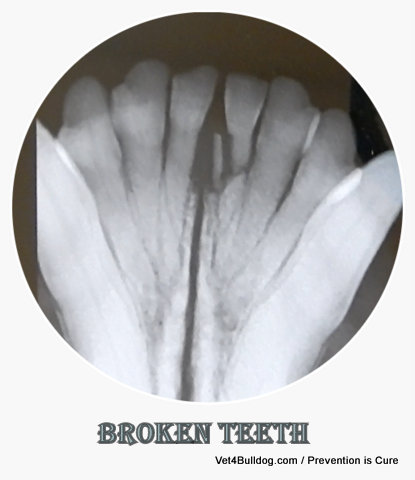
BULLDOG DENTAL ANESTHESIA:
Because precise imaging is required, dental radiographs must be performed under general anesthesia to ensure the dog remains still and comfortable.
For optimal diagnostic accuracy and safety, a professional-grade dental X-ray unit and trained veterinary staff with dental expertise are necessary. Proper technique and equipment significantly improve the detection of hidden pathology and support effective treatment planning.
#3 Bulldog Dental Scale and Polish
A thorough dental cleaning—commonly referred to as dental scaling and polishing—is a key component in the prevention and treatment of periodontal disease in Bulldogs and French Bulldogs.
To perform this procedure safely and effectively, general anesthesia is required. This ensures that the dog remains still and pain-free during the process, allowing the veterinary team to:
🩺 ORAL EXAM Conduct a comprehensive oral examination, including probing for periodontal pockets
🩺 DENTAL READIOGRAPHS: Obtain dental radiographs to detect disease below the gum line
🩺 DENTAL SCALING: Perform scaling (removal of plaque and tartar from above and below the gum line)
🩺DENTAL POLISH: Complete polishing to smooth the tooth surfaces and slow future plaque buildup
⚠️BULLDOG ANESTESIA SAFETY
⚠️Due to the brachycephalic (short-nosed) anatomy of Bulldogs, anesthesia must be administered with special care by a trained veterinary team using appropriate monitoring and airway management techniques. When performed correctly, dental scaling and polishing is a safe and highly beneficial procedure that supports long-term oral health.

Dr. Kraemer’s Bulldog Dental Cleaning Rule of Thumb 👍
🦷 Professional dental cleanings for bulldogs should always be performed under anesthesia!
⚠️ Anesthesia-free dental cleanings are strongly discouraged and not recommended by the American Animal Hospital Association (AAHA) or the American Veterinary Dental College (AVDC).
Bulldog Dental Tips & Warnings
The selected dental tips and warnings are courtsy of Dr. Kraemer
#1 ⚠️Bulldog Anesthetic Dental Cleaning Warining:
It’s natural for Bulldog and French Bulldog owners to be concerned about the use of anesthesia. However, dental cleanings without anesthesia are inappropriate and unsafe for several critical reasons:
Legal and Licensing Warning: In the United States and Canada, only licensed veterinarians are legally permitted to perform dental procedures and in some cases RVT (registered veterinary nurse). Anyone else performing dental services on your bulldog is illegally practicing veterinary medicine and may face criminal charges.
Always prioritize your bulldog’s safety and dental health by choosing a qualified veterinary team that follows established medical guidelines.
#2 ⚠️Bulldog Dental Cleaning Without Anesthesia – Ultrasonic Scaler Warning
Anesthesia-free dental procedures in Bulldogs and French Bulldogs can result in incomplete exams and inadequate cleaning.
Ultrasonic Scaler Danger Without Anesthesia:
Dental tartar is firmly adhered to the surface of your bulldog’s teeth and requires ultrasonic or sonic power scalers for proper removal. These instruments have sharp working tips and must be used with precision.
When a bulldog is awake and unrestrained, even minor movements can result in:
🚨Pain during scaling
🚨Injury to the gums, tongue, or other oral tissues
🚨Biting risk to the person performing the cleaning
Without anesthesia, it is impossible to safely and thoroughly clean the teeth or assess the full extent of dental disease below the gumline.
#3 ⚠️Bulldog Dental Without Anesthesia – False Sense of Security Warning
Anesthesia-free dental cleanings create a dangerous illusion of health and effectiveness.
True professional dental care includes:
⚕️Scaling above and below the gum line
⚕️Cleaning within the gingival pockets—the critical subgingival space where periodontal disease begins
⚕️Polishing to smooth the enamel and reduce future tartar buildup
In Bulldogs—as in all dogs and cats—accessing and thoroughly cleaning beneath the gum line cannot be done safely or effectively while the pet is awake.
Simply removing visible tartar from the tooth surface is cosmetic and does little to treat or prevent dental disease. Worse, it gives owners a false sense of security while the real disease continues unchecked below the surface.
🚨Subgingival cleaning in pets is impossible without anesthesia.
#4 ⚠️ Bulldog Dental Cleaning Without Anesthesia – Oral Exam Warning
A complete oral examination is a critical part of any professional dental procedure.
Without anesthesia, a full and thorough exam is impossible.
In an awake bulldog, the following limitations apply:
🚨Inner (lingual) tooth surfaces—those facing the tongue—cannot be properly visualized
🚨Hidden areas of disease or pain may go undetected
🚨Important conditions like fractured teeth, oral tumors, or deep periodontal pockets may be completely missed
Skipping anesthesia means skipping the opportunity to truly assess your bulldog’s oral health.
#5 ⚠️ Bulldog Dental – Toxins Warning
Anaerobic bacteria thrive below the gum line and are a major cause of dental disease in bulldogs.
These bacteria release endotoxins, which can:
🚨Destroy surrounding gum tissue
🚨Erode the supporting bone
🚨Ultimately leads to tooth loss
Without proper subgingival cleaning—only possible under anesthesia—these harmful toxins continue to damage your bulldog’s mouth silently and progressively.
#6 ⚠️ Bulldog Dental Disease – Systemic Health Warning
Periodontal disease in Bulldogs and French Bulldogs doesn’t just stay in the mouth. Bacteria from infected gums can enter the bloodstream and travel to vital organs, where they may:
🚨Damage heart valves (endocarditis)
🚨Impair kidney and liver function
🚨Even contribute to neurological issues affecting the brain
Dental disease is more than just bad breath—it’s a serious medical condition that can compromise your bulldog’s overall health and lifespan.
#1 🩺 Bulldog Dental Anesthesia – Safety Tip
While no anesthetic procedure is entirely risk-free, the modern protocols used in our veterinary hospital significantly reduce risk—especially when compared to the long-term health benefits of professional dental care for your bulldog.
At our facility, Dr. Kraemer implements bulldog-specific anesthetic protocols, tailored to the unique needs of the breed. We use only Sevoflurane inhalation anesthesia—a safer, faster-acting alternative to the more commonly used (and less expensive) Isoflurane.
Every bulldog dental patient is also intubated with a cuffed endotracheal tube, which provides three key benefits:
⚕️Ensures safe cooperation from a patient unable to understand or remain still during the procedure
⚕️Prevents pain and distress during examination and treatment
⚕️Protects the airway—greatly reducing the risk of aspiration and life-threatening inhalation pneumonia
These safety measures help ensure your bulldog receives the care they need with minimal risk and maximum comfort.
#2 🩺 Bulldog Dental Care – Antibiotics Tip
In some cases, pre-dental antibiotics may be recommended for Bulldogs and French Bulldogs—especially when:
💊 There is advanced periodontal disease
💊 Tooth extractions are anticipated
These antibiotics help reduce bacterial load and inflammation before the procedure, improving safety and outcomes. Always follow your veterinarian’s guidance on antibiotic use tailored to your bulldog’s specific condition.
#3 🩺 Bulldog Dental Care – Pain Control Tip
Pain management is essential following any dental procedure involving extractions.
Every Bulldog or French Bulldog who undergoes tooth extraction should be sent home with appropriate pain medication to ensure:
⚕️Comfort during recovery
⚕️Faster healing
⚕️Reduced stress and inflammation
#4 🩺 Bulldog Dental Care – Polishing & Fluoride Tip
Every professional dental cleaning for Bulldogs and French Bulldogs should include:
⚕️Polishing to smooth the tooth surfaces and remove microscopic abrasions that attract plaque
⚕️Fluoride treatment to strengthen enamel and help prevent future infection
These final steps are essential for maintaining oral health and reducing the risk of rapid tartar re-accumulation.
#5 🩺Bulldog & French Bulldog Dental Prophylaxis Tip:
To support your bulldog’s oral health before and after professional dental cleaning, I recommend daily dental home care that includes:
🌿Antiseptic oral wipes to reduce bacterial buildup
🌿Dental water additives, such as Dr. Kraemer’s Dental Defense, to help control plaque and freshen breath (
Consistent at-home dental care is essential to maintain the results of professional cleanings and help prevent future periodontal disease.
#6 🩺 Bulldog & French Bulldog Teeth Scaling Tip
A complete dental cleaning for Bulldogs and French Bulldogs should include both:
⚕️Ultrasonic scaling – to efficiently break up and remove tartar above and below the gum line
⚕️Hand scaling – to access hard-to-reach areas and ensure thorough cleaning of all tooth surfaces
This dual approach is essential for removing plaque and tartar buildup, preventing periodontal disease, and protecting your bulldog’s long-term oral health.
#7 🩺 Bulldog Dental Care – Extractions Tip
Tooth extractions in Bulldogs and French Bulldogs should be considered when:
-
The bone surrounding the tooth is infected
-
The tooth is fractured with root exposure
For all extractions, we strongly recommend:
⚕️Local nerve blocks using a local anesthetic to manage pain
⚕️Surgical closure of the extraction site to reduce infection risk, minimize discomfort, and promote faster healing
Proper technique during extractions ensures a safer procedure and a more comfortable recovery for your bulldog.
Recommended by Owners Approved by Bulldogs



